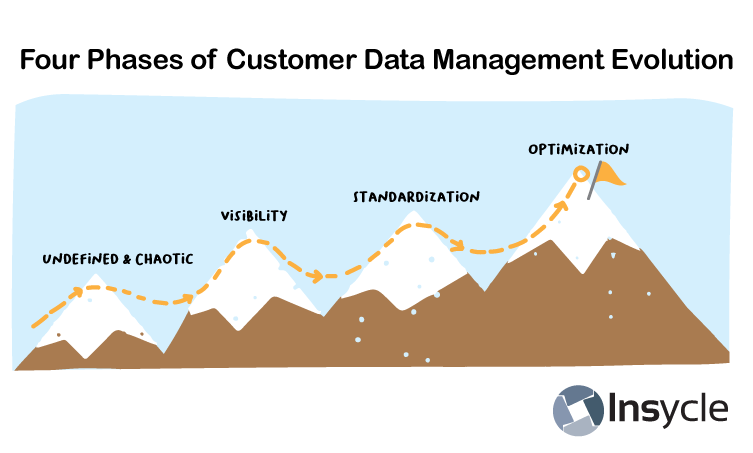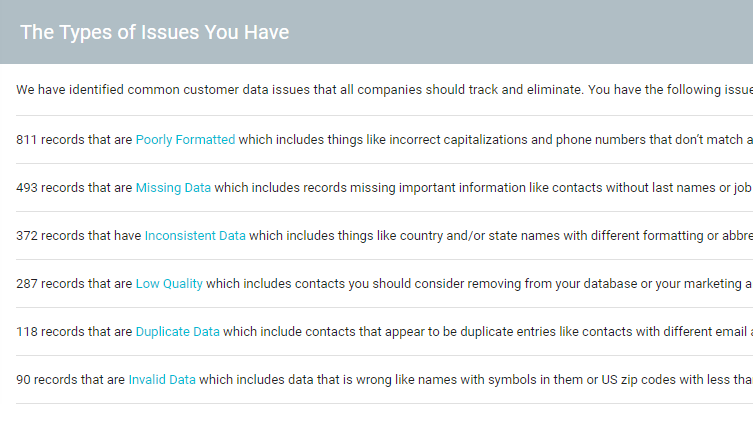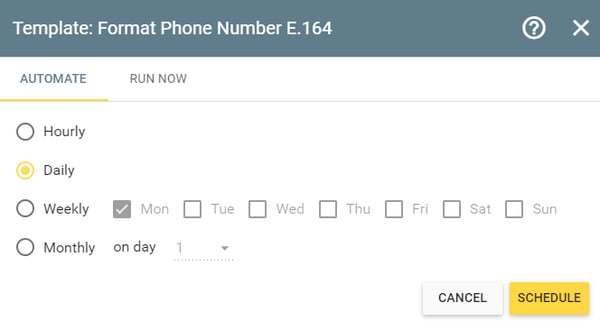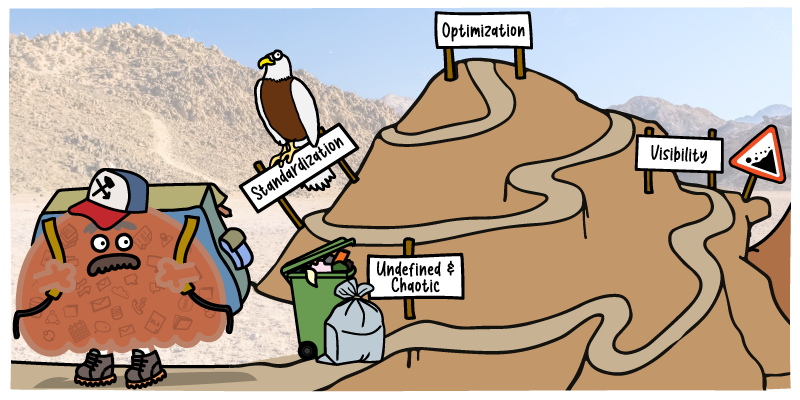But over time, as your customer data grows and becomes more complicated, it necessitates a higher level of focus and planning around how you organize, cleanse, nurture, and generally manage that data — or at least it should.
Companies that recognize the importance of customer data management are the ones that are primed for growth. They provide better experiences to customers. They speak to them more clearly and with focus on the subjects that are most important to them. They are able to better segment customers. They identify and seize opportunities more consistently. Ultimately, they are just more effective in how they spend their time and the strategies that they pursue. Those that overlook proper data management often see their growth stagnate and fail to reach their goals.
Companies without effective data management practices in place will see their marketing and sales initiatives falter and data storage costs balloon. Most companies look to data management as a way to improve data organization, but data management is also a useful cost-savings tool as you remove redundant and useless data from your systems. Imagine improving your sales and marketing while lowering the costs of the apps that you use.
In a Harvard Business Review's article, it is estimated that bad data costs companies $3.1 trillion per year. The average business loses as much as $9.7 million due to bad data. Having effective data management in place not only brightens future long-term prospects but puts companies in a position to capitalize on opportunities in the present as well.
In this article, we’ve broken down the different phases of customer data management that companies go through as they build, evolve and improve their data strategy. Each phase represents a significant improvement over the previous phase and a significant step forward for the companies that make the leap.

Phase 1: Undefined & Chaotic
The majority of companies are in this phase, including very successful ones. It’s the natural starting point when it comes to data management and until you begin to take action to improve your standing and move to the next phase. That isn’t something to feel bad about — every growing company starts here. At any given time there are a million fires that a company has to put out and data management often slides down the list of priorities, even when it shouldn’t.
Up to that point, data grows organically. Often, that is a sign of success. You’re growing. You have more customers. A database full of customer records with issues is still better than a clean customer database with just few records.
Companies at this phase are collecting customer data, which should include any active company with sales and marketing departments, but for various reasons, they have not yet established solid plans for organizing, managing, and leveraging that data effectively.
When you’re in this phase, you can feel it in your day-to-day work. You (and your team) might not know where the “correct” data is stored. Maybe you have redundant fields or store data on multiple platforms and have a tough time quickly discerning where the most updated customer data is held. In some cases the most recently updated profiles could even be split between multiple platforms, making it impossible to use.
You might run into specific issues when you try to make use of the data. Maybe contacts and leads aren’t assigned to the right company. Or you have a database that is chock-full of redundant and missing data. Maybe your data is full of formatting issues that keep you from using it in any kind of customer-facing way.
Companies in this phase are often handling customer data management on an ad-hoc basis. Employees are entering lead data as they collect it. They create their own fields and filters. People prepare personal reports. No one has the job of actually owning the data quality, which means that no one is invested in ensuring that it improves. Everyone is focused on their own specific responsibilities and the tasks that they need to execute.
Finding someone to help you deal with customer data problems is quite challenging. Many companies resort to hiring a consultant to perform specialized one-off data tasks, such as deduplicating contact and company records, or importing data.
These short-term engagements can alleviate some pain, but without adopting standards and systems to prevent those issues from happening, the same issues will surface and reoccur. In addition, companies often fail to realize the data access risks involved when engaging with external consultants, seemingly every other week we read about the latest data breach in the news.
In this phase, companies have limited monitoring and little to no metrics about the quality of their data, how data is used, data validation errors, email deliverability issues, and other problems that affect their business. This impacts cross-team productivity and pushes the company toward an unaligned state.
Companies at this level will find it difficult to discern real value from the data that they collect in their Marketing Automation or CRM systems like Salesforce, HubSpot, Intercom, Zendesk, and many others.
Do you know what you have in your database? Many mid-size companies are in this phase — it’s not that you have to have proper customer data management to grow — it just makes things a whole lot easier. There are many companies that fall into this category. Many early-stage startups fall into this tier and will have a tough time becoming anything much more than an “early stage” startup if they don’t embrace proper customer data management.
Companies in the “Undefined & Chaotic” phase may know they have data problems but have no real context for what those data problems are or how they can fix them.
|
Related articles Find & Fix Customer Data Issues with Insycle’s New Health Assessment Declutter Your CRM By Purging Low-Quality Data Automatically |
Phase 2: Visibility
The first step in improving your customer data management practices is understanding what problems you actually have within your data and how they impact your business.
As an example, missing data can impede lead scoring and routing strategies. Free email accounts could clutter your database and increase costs. Poorly formatted data, like uncapitalized first names, could negatively impact your marketing personalization.
With an understanding of what your problems are, you can begin to take a more strategic approach toward addressing those issues.
It requires a thorough assessment of your customer data. You need a way to identify which records have data issues and business validation errors. You need an easy way to gain visibility into the data on a regular basis, not just a huge one-off data cleaning effort. It needs to be customizable to fit the context of your business.
With an understanding of what your problems are, you can begin the task of identifying what caused your most glaring issues in the first place.
This delivers numerous benefits.
Benefits of Visibility:
- Understand where your data problems lie. Do you have many duplicate records? Data inconsistency issues? You can only fix problems that you are aware of. Customer records experience turnover every year as people change titles, companies, and email addresses. What is good, clean data today may be inaccurate in six months.
- Gain visibility into how those problems are impacting your business. What is limiting your ability to create highly targeted campaigns use in your marketing automation? What is shattering your single customer view, impacting the context that your sales team has to work with? Your data issues have a real-world impact, but without deeper consideration, the effect is not always apparent.
- Begin to formulate a plan for dealing with those data issues. With visibility, you can begin the process of pinpointing why certain data issues continue to occur. Are they human data entry issues? Do your customer-facing forms have proper validation? Is data being imported incorrectly? Are you storing a bunch of redundant or useless data that is inflating costs?
- You can only improve what you can measure. With visibility, everyone can see where data problems lie. This creates opportunities for conversations and new viewpoints. Management will understand the hidden problems that affect the business efforts to spark movement in the right direction and allocate resources.
Phase 3: Standardization
With visibility and understanding of the current state of your data, you can progress towards the next phase and define the target state, a data management plan and processes that the plan encompasses. This will serve as a blueprint for the way that your organization handles data.
Many companies try to establish data quality standards through documentation. While documentation is useful, customer data is like a living organism, it evolves frequently and the way its used changes to meet new challenges.
Documents can become outdated quickly, and it is difficult for your team to implement those standards by following a manual. You need a way to measure and enforce standards, to see when exceptions occur and to monitor alerts and dashboards for an ongoing management of the data. These standards can include things like required fields for lead scoring and routing, a consistent convention for job titles for creating campaigns and reports (CEO vs. Chief Executive Officer), or a normalized address, state, and country conventions.
Standardization is about defining the rules for your data, eliminating the paralyzing ambiguity that happens when data grows organically in an uncontrolled manner. Your teams will better understand what is expected from them, how data impacts cross-team activities, which fields are required by sales, marketing, support, finance, and operations. Everyone will know who needs to enter the data, what needs to be fixed and how, and when updates should occur.
The issues uncovered in your data visibility informed the plan and processed that you put together, next visibility will also ensure conformity to the standards that you have developed.
Benefits of Standardization:
- Operationalize your data. Ensure that your data has set procedures and processes that help you integrate it into your sales and marketing activities.
- Alignment. With clear standards and defined processes, everyone will know what is expected of them and be on the same page regarding data quality, enabling service level agreements between departments.
- Set clear data goals. With visibility into your problems and a clear plan in place, Recan begin to outline goals for improvement.
- Fix data issues from any source. Identify and fix the true causes of a variety of data issues, whether it be input errors, improper validation, import issues, or any other.
Phase 4: Optimization
The highest rung on the customer data management ladder. Organizations that reach this level know their most common problems, have well-defined data management standards and employ automation.
Making the leap to Phase 4 — Optimization — is about going from reactive to proactive, and handling data management at scale with a machine to execute your desired standards. You have a much deeper level of transparency about your data and can identify what is working and what's not. Additionally, you have more control over your costs and wasteful spending. Alerts and notifications keep everything the machine handles working as expected.
You can get to visibility manually. You can define the standards manually on paper. But to move into the optimization phase, you need automation and processes behind those standards. Then you’ll be able to accomplish your business objectives.
With defined standards and processes in place, you can then enter the next level of data management maturity and focus on optimizing your data.
Optimization is about finding the best ways to implement, execute, and refine your standards and processes. For many, that will come in the form of automation.
With the right systems in place to ensure higher quality data enters your databases, you can reach the next level by installing automation where it makes sense. That way, when data problems do enter your database, that can be automatically identified and fixed.
Benefits of Optimization:
- Consistent, reliable customer data quality. Companies in this category can use their data without worry that it will be filled with embarrassing errors that harm their reputation.
- Reduce manual data cleansing. Monitoring and fixing issues by hand are more time-consuming and error-prone than having aspects of your data cleansing automated.
- Reduce data silos and maintain a single customer view. Ensure that all teams have access to the same data when they need it. Maintain a single customer view throughout the Customer Lifecycle.
- Improve segmentation and personalization. Speak more directly to your prospects with accurate context and deliver a better, more focused experience.
- Identify more opportunities. When you know your customers on a deeper level you can identify opportunities, optimize your advertising budgets, and figure out what is driving revenue growth.
- Improve time work. Share data and collaborate more effectively. Improve morale by reducing frustration by freeing your team to focus on important tasks instead of continuous maintenance.
- Optimize budgets. Don’t overpay for what you don’t need. Reduce redundant and underperforming investments and costs.
How Insycle Helps Companies Level Up Their Customer Data Management
Insycle is a customer data management solution that is designed to help companies organize, manage, and optimize their customer data in order to execute more efficiently on their business objectives.
Visibility
The Insycle’s Customer Data Health Assessment can help companies evolve to the “Visibility” phase. When you sign up, Insycle will begin analyzing and auditing your customer data automatically through any platform you connected to Insycle — HubSpot, Salesforce, Intercom, Mailchimp, Pipedrive, Zendesk, or any other.
The Health Assessment will scan your data for more than 30 of the most common customer data issues, including things like duplicate data, poorly formatted data, missing data, and inconsistent data standardization issues. Then, the system will continue to analyze your data on a daily basis so that you always have an up-to-date look at where your data problems lie.
You can add custom templates within Insycle to your Health Assessment to track particular issues that are unique to your business. This not only helps you to improve data quality but gives you a custom reporting tool for specific customer data health issues and a shared dashboard for the entire team and management.

With Insycle’s Customer Data Health Assessment, any company can effectively evolve to Phase 2, the “Visibility” Phase.
Standardization
Through Insycle, you can define standards and implement your data strategy by developing your custom templates to ensure that your data is consistent. You can design and enforce your data strategy completely through Insycle, providing a top-down view with a dashboard for every relevant member of your team.
Optimization
Insycle makes automation simple. The Health Assessment not only pinpoints the issues that exist within your data, but it also provides direct links to fixing those issues within the platform.
After defining standards and templates, you can schedule Insycle to run them automatically on a recurring basis.

Click below to connect your company’s CRM to Insycle and generate your free Customer Data Health Assessment.






